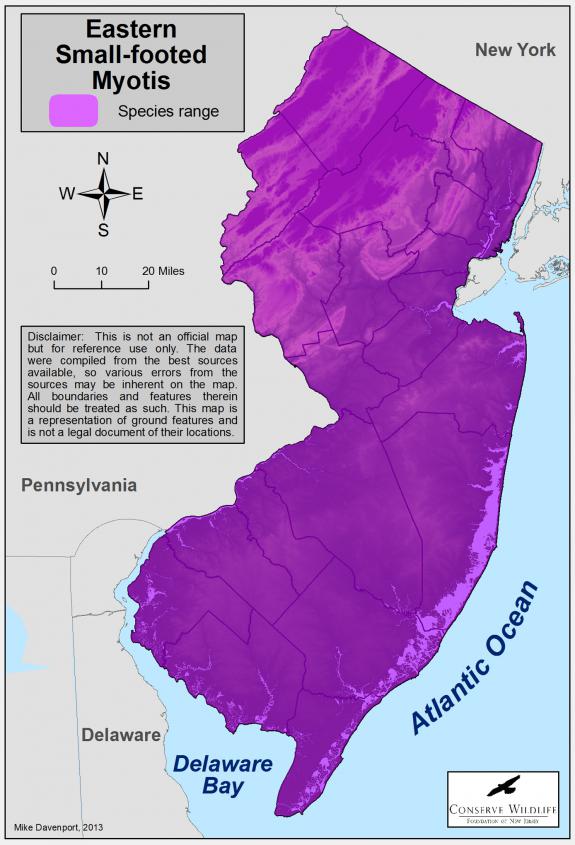Myotis leibii
Type: mammal
Status: endangered
Species Guide
Eastern small-footed myotis
Myotis leibii
Species Type: mammal
Conservation Status: endangered
IDENTIFICATION
The eastern small-footed bat is the smallest member of the Myotis genus. Its feet are distinctly smaller than any other’s within the genus, measuring less than 9 mm in length. Small-footed bats have black-accented golden brown fur and a solid black face. They weigh between 3.5 and 6 grams, are about 3 inches long, and have a wingspan of 8 to 10 inches. Males and females are generally the same size. Their wings are broad and rounded, allowing for slow yet agile flight through dense habitats.
The small-footed bat has a sloped forehead, differing from the typical broad forehead of other Myotids. This bat also has a strong keel on its calcar, which is the spur of cartilage running from the inner ankle along the bottom edge of the interfemoral membrane (between the foot and tail). Little brown bats (M. lucifugus) and tri-colored bats (Perimyotis subflavus) lack keels. Tri-colored bats have pink forearms, further differentiating the species.

Distribution & Habitat
The eastern small-footed bat is widely distributed throughout the United States and Canada, ranging from Ontario and the northeastern U.S. states to Georgia, along the Appalachian Mountains, through the Ozarks, and as far west as Oklahoma.
Small-footed bats use a variety of roosting sites within forested regions, including crevices in sunlit rock piles, talus slopes, and outcroppings, beneath tree bark and in tree crevices, in caves, and occasionally even in buildings. These bats prefer colder, drier hibernacula in winter than other bats that hibernate in the region. Hemlock forests seem to be favored over other forest types. The bats usually return to the same mines and caves each winter. They are generally the last to enter hibernation in fall and the first to emerge in the spring.
Diet
Eastern small-footed bats are insectivorous and mainly eat mosquitoes, beetles, and moths. They hunt while flying slowly over water bodies where insects are abundant. Because these bats sometimes roost on the ground, they are also known to eat ants and other crawling insects as well. Small-footed bats may pick prey off of rocks or other substrates while flying by; this habit is called gleaning.
Like other insect-eating bats, small-footed bats use echolocation to navigate and find their prey. These bats emit high-frequency calls – around 20 pulses per second – while searching. The echoes reveal the size, shape, distance, and trajectory of insects, enabling bats to follow their movements and ultimately snatch their prey from the air. As they hone in, bats increase their calls to up to 200 pulses per second in what is referred to as the “feeding buzz.”
Life Cycle
Like many bat species, small-footed bats engage in fall mating swarms prior to entering hibernation. Males and females will have many mates during this time. Females store sperm over the winter and ovulate in the spring, delaying pregnancy until food resources are available again. They arrive at their maternity colonies in May, and pups are born in late May or June. Females give birth to just one pup per year and nurse for about a month. Males live separately from females and are not involved in pup rearing.
Small-footed bats typically live 6-12 years in the wild, depending on predation and parasite loads. Common predators of these bats are owls, hawks, raccoons, snakes, and weasels. Males typically live longer than females, which is thought to be due to the high energy demands of pregnancy and nursing.
Current Threats, Status, and Conservation
Although the International Union for Conservation of Nature (IUCN) considers the eastern small-footed bat a “least concern” species, many other entities are now classifying it as “threatened,” “imperiled,” or “of special concern.” The U.S. Fish and Wildlife Service reviewed the species for Endangered Species Act listing in 2013 but did not pursue the listing. Since these bats are so dependent on dense forests and a specific type of hibernaculum, they are vulnerable to disturbance and the loss of critical habitats. Range-wide, about 90% of small-footed bat roosting sites are found on private land.
Like other temperate bats, eastern small-footed bats are now also threatened by the fungal disease known as White-nose Syndrome. White-nose Syndrome is caused by a fungus (Pseudogymnoascus destructans) that grows incredibly well in the cold, moist environments of caves and mines, where it invades the tissues of hibernating bats during winter. The infection causes wing deterioration, water loss, and arousals that cost bats their critical energy reserves. Mortality rates exceeding 95% have been documented at winter dens across 25 U.S. states and 5 Canadian provinces (as of October 2014).
In 2013, the New Jersey Endangered and Nongame Advisory Committee recommended an Endangered status for this species. In January 2025, the rule proposal for upgrading the species status was finally adopted.
- Learn about the work being done to research and protect NJ’s bats at our Bat Project webpage.
References
- Bat Conservation International
- Center for Biological Diversity
- University of Michigan Museum of Zoology
Text written by Heather Kopsco and MacKenzie Hall in 2014.
Scientific Classification
- Kingdom: Animalia
- Phylum: Chordata
- Class: Mammalia
- Order: Chiroptera
- Family: Vespertilionidae
- Genus: Myotis
- Species: M. leibii